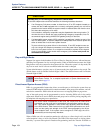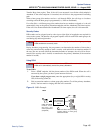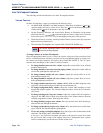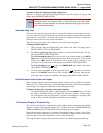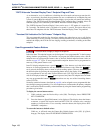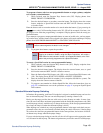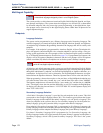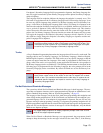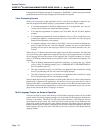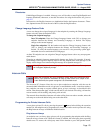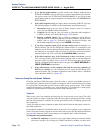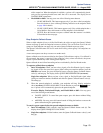
System Features
INTER-TEL
®
CS-5200/5400 ADMINISTRATOR GUIDE, ISSUE 1.1 – August 2005
Page 172 Multilingual Capability
Multilingual Capability
The system provides a choice between American English, British English, Spanish, and Japa-
nese prompts and displays. The system selects the language to use for each call, as determined
by the trunk, endpoint, and voice processing system programming, as described below. Japa-
nese prompts can be viewed only on the digital display phones. Other Inter-Tel phones do not
support Japanese displays.
Endpoints
Language Selection
The system can be programmed to use a Primary Language and a Secondary Language. The
available languages are American English, British English, Mexican Spanish, and Japanese.
An endpoint flag in Database Programming determines the language that will be used by each
endpoint.
For example, if the endpoint is programmed for American English, all Inter-Tel endpoint dis-
plays will appear in American English. Also, when the endpoint is used for calling a voice pro-
cessing system application, the voice prompts will be in American English (unless overridden
by a Call Routing Announcement as described on page 174). If programmed for Japanese, the
displays will be in Japanese (Katakana) characters and the voice prompts will be in Japanese
(unless overridden). By default, all endpoints are set for the system’s Primary Language.
All displays and default messages in the system are provided in American English, British
English, Japanese, and Spanish. Endpoint-programmed messages, including those programmed
through the administrator’s endpoint, can include English/Spanish or Japanese characters, or a
combination. In displayed lists, such as directories, the English/Spanish characters are alpha-
betized before the Japanese characters. Therefore, Japanese names will be at the end of the list.
When programming a feature that requires a time and date, an English/Spanish endpoint user
will enter the date in the order “month, day, year” and the time in the order “time, AM/PM.”
The Japanese endpoint user will enter the date as “year, month, day” and the time as “AM/PM,
time.” The displays show the time and date differently, as well. For example, the English/Span-
ish display will show the time and date as “12:25 TUE NOV 28” and the Japanese display will
show “TUE 11/28 12:25.”
Secondary Language Selection
A field titled “Secondary Language” is provided for each endpoint in the system. This field
corresponds to the Change Language feature (301). This feature toggles between the System
Primary Language and the endpoint Secondary Language, or it can specify a language. This
allows any endpoint in the system to have its own secondary language or use the System Sec-
ondary Language, giving the system the ability to support more than two languages.
If an endpoint’s Secondary Language field is programmed as Use Primary Language, the
Change Language feature will do nothing because the endpoint will toggle between the System
Primary Language and the endpoint Secondary Language (the System Primary Language).
If a phone’s Secondary Language field is programmed as Use Secondary Language, the
Change Language feature will toggle between the System Primary Language and the phone’s
Secondary Language, which is the System Secondary Language. This state is the system
default.
NOTE
This feature requires 0 feature units, but it is installer-programmable to prevent
unintentional language changes by users in an all-English system.
NOTE
Only digital display endpoints will display Japanese prompts. Other Inter-Tel end-
points do not support Japanese displays.



